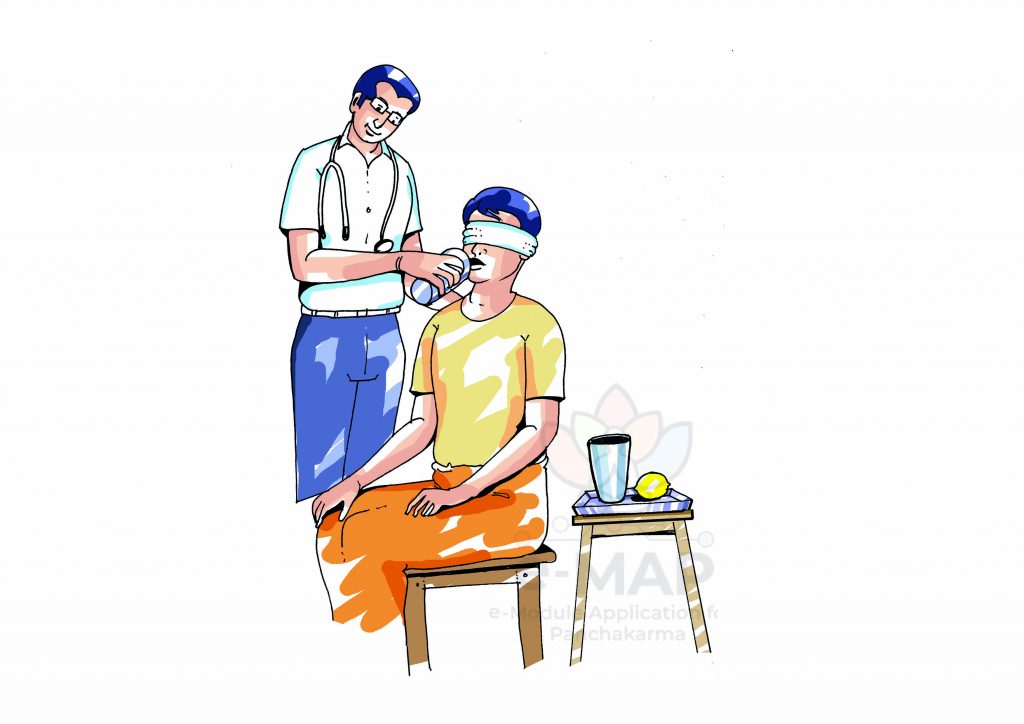
Basic Module 2 - Lesson 15
SNEHANA

EXPLANATORY NOTES
According to Kashyapa, Avapīḍaka snehapāna it is best for pitta and anila. It strengthens the bladder, thighs and hips. It is aphrodisiac, provides enthusiasm and removes tiredness.
जीर्णान्तिकं च उत्तमयमात्रया योजनद्वयं |
अवपीडकंतत्चसंजितं – Ah.Su.4/6
सर्पिषो अवपीडक: यत्रसर्पि: पीत्वातत्पीडकं अन्नंभुज्यते || -चक्रपाणि on Ch.Chi.28/98
जीर्णातिकं च उत्तमयमात्रया योजनद्वयं |अवपीडकंयेतत्संजितं || – अ.ह्र.सू.४/६
Avapīḍaka snehapāna is either used for doṣa utkleśana or śodhana pūrvaka snehapāna. Its action is either doṣa śamana or bṛṃhaṇa
The word yojanā dvayam is interpreted in 2 ways.
It can be administered in two ways Initially ghee (medicated) is administered in a low dose (hruswamātrā) followed by (after some time, when the patient is relaxed after exhausting ghee drinking) light food (maṇḍa or yūṣa). Once the patient develops proper hunger (udgāra śuddhi, ruci and laghutā) once again the ghee must be given in uttama mātrā dose.
In the second method instead of administering hraswa mātrā in the beginning (before food), uttama mātrā is given followed by food and once the food is digested once again uttama mātrā ghee is given.
Note: As per aruna Dutta in mūtra rodha janya vikāras, adho nābhi vikāras etc uttama mātrā or hraswa mātrā ghee is given first, followed by food and then uttma mātrā ghee is used.
In raktaja arsha, (Bleeding piles), when the bleeding is not stopping even after proper treatments then avapīḍana snehana must be administered as a last option. First, hirswa mātrā ghee mixed with kouṣṇāmaamsa is administered and after its digestion once again Luke warm ghee is given. (Here Avapeeda sneha acts as bṛṃhaṇa. In Raktaja arśas due to heavy bleeding rakta kṣaya, ojokṣaya and vāta vardhaka is enormous hence bṛṃhaṇa avapīḍaka is advised.)
Dose fixation of avapīḍaka sneha:
Ghee should be administered when the person is hungry, in the morning either in the form of uttāma mātrā or hirswa mātrā.The dose must be decided according to the agni and koṣṭha of the person. Or in quantity wise one pala-50ml.
उत्तमस्य फलं मात्रा। शा.स.उ.117
जघन्यस्य पलार्ध अथवा द्विकर्षिका। (Sha.Su. Ch-17)
Diet during avapīḍana snehapāna:
अत्र च उत्तमया मात्रया स्नेहपानानन्तरं पथ्यं कार्यं। -अरुणदत्त
पेया यूषो रसो वा स्यादकृतः कृतोवा।
अल्पाल्य सर्पिष्को विलेपि वा विधीयते॥ ( सु.चि. 32/ 31/34.)
Practically 50ml can be given as prāk bhaktam (prior to food) and again100-250 ml can be given after the digestion of the food. If uttāma mātrā is used, then for a maximum of 7 days it can be administered or until samyak snigdha lakṣaṇas. If hirswa mātrā is given then it can be continued until Roga śamana.
Utility of avapīḍaka sneha:
Prākbhakta is indicated in the apānavāta vaiguṇya. All the diseases controlled or cured by avapīḍaka snehapāna is due to pratiloma gati of (upward direction) of apānavāyu.
To correct this pratiloma ghṛtapānavāta is done by administering ghee, that is pīḍana (squeezing) of pratiloma vāta doṣa. This is the reason behind the name Avapīḍaka.
Avapīḍaka snehapāna which is snigdha guṇa pradhāna is very much useful in pathology initiated by rūkṣa guṇa of vāta in various mūtravega rodha janya vyādhis.Due to the suppression of mūtra, adhovāta and purīṣa Vegas, both apāna and vyāna vāyu get deranged. Avapīḍaka snehapāna corrects pathophysiology of deranged apāna and vyāna vaāyu’s. Hence it is considered as a unique therapeutic method to treat mūtravega rodha, udāvartaja śukraja etc vikāras.
Ghṛta is preferred in avapīḍana sneha due to its vātanulomana and agni vardhaka Guṇas.The therapeutic utility of Avapīḍaka snehapāna can be further extended for the treatment of similar diseases where apānavāta vaigunya is noted.
IMPORTANT SLOKA
मूत्रजेषुतुपानेचप्राग्भक्तंशस्यतेघृतम्॥६॥
जीर्णान्तिकंचोत्तमयामात्रयायोजनाद्वयम्।
अवपीडकमेतच्चसंज्ञितं—————–।। (A.H.Su. 4/6)
In the diseases, due to the suppression of urine medicated ghee is to be given internally before food and after the digestion of food in a quantity of minimum and maximum doses respectively. This method of administration of medicated ghee is known as avapīḍaka.



